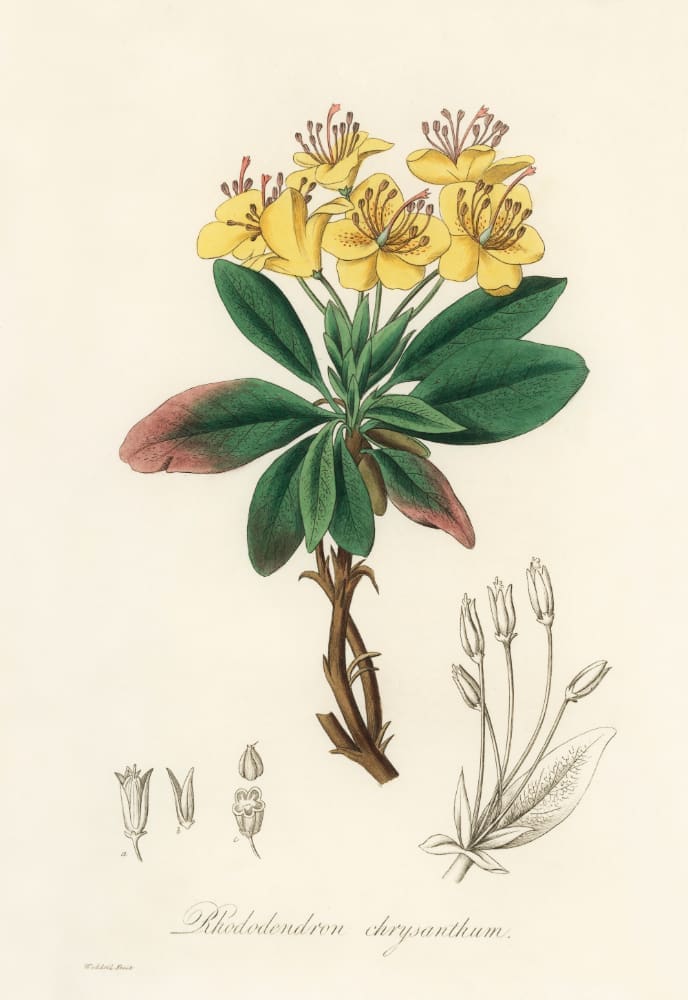
Rhododendron chrysanthum
Latin name: Rhododendron chrysanthum
Short name: Rhod
Common name: Yellow Rhododendron | Siberian Rhododendron | Alpine Rose
Primary miasm: Psoric Secondary miasm(s): Sycotic
Kingdom: Plants
Family: ericaceae
- Symptomatology
- Remedy Information
- Differentiation & Application
This hardy, small-leaved evergreen shrub from Siberia grows in cold alpine regions and survives harsh climates. In its crude form, it contains andromedotoxin (a grayanotoxin), which affects the nervous system and heart. In homeopathy, it is known for its powerful affinity for rheumatism, weather-sensitivity, and neuralgia, particularly those symptoms worsened by storms or barometric changes.
No significant traditional or pharmacological uses due to its toxicity. In folk medicine, used cautiously for joint pain and gout.
Proved by Hahnemann; confirmed by clinical application in rheumatic and neuralgic disorders
- Fibrous tissues – tendons, ligaments, periosteum
- Joints – especially small joints, like fingers, wrists, toes
- Testes and scrotum – drawing, aching pain
- Head and occiput – neuralgic pain with weather change
- Nerves – particularly periosteal and dental neuralgia
- Eyes – sensitive to light and pressure
- Bones – affected by cold and damp
- Warm weather
- Continued motion
- Pressure on affected parts
- Lying on the painful side
- Eating
- Before and during storms
- Change in barometric pressure
- Cold, damp weather
- Rest
- Touch
- Night
- Wind and drafts
- Thunderstorms
- Rhus toxicodendron – Worse in cold and damp, but more restlessness and red skin
- Bryonia – Pain worse from motion, opposite of Rhod.
- Dulcamara – Worse from cold damp, but more cutaneous eruptions and mucosal involvement
- Colchicum – Gout remedy with sensitivity to touch, but less weather focus
- Ruta – Focused on ligaments and tendons, especially after strain
- Calcarea carbonica – Cold-sensitive, but more constitutional coldness and swelling
- Complementary: Rhus tox, Calcarea phos
- Antidotes: Camphora, Aconitum
- Follows well: Bryonia, Pulsatilla
- Inimical: Sulphur (when used in high potency during active storm symptoms)
Rhododendron chrysanthum encapsulates meteorological sensitivity—a human barometer. Its essence is anticipation of environmental change, felt deeply in the bones and nerves. Pain shifts, joints ache, the mind dims—all before the sky breaks open. The patient is stoic yet overwhelmed, unable to act until the storm passes. A remedy for rheumatic, gouty, and neuralgic constitutions who become symptomatic with every change of season, wind, or thunderclap.
- A top remedy in rheumatism or neuralgia preceding a storm
- Useful in testicular pain or inflammation, especially from cold exposure
- Consider for dental neuralgia in barometric-sensitive patients
- Helps patients with gout aggravated by cold and weather
- Excellent for climactic sensitivity in elderly or debilitated constitutions
Extremities
- Rheumatism, before storms
- Pain, shifting
- Joints, tearing pain
- Gout
- Motion ameliorates
Teeth
- Toothache, before storms
- Neuralgia of jaw
Mind
- Anxiety before storm
- Forgetfulness
- Dullness during pain
Male Genitalia
- Pain in testes
- Testes, drawing sensation
Generalities
- Weather changes aggravate
- Storms, before and during, aggravate
- Motion ameliorates
- Cold damp air aggravates
- Samuel Hahnemann – Materia Medica Pura: Provided original proving and characteristic modalities related to weather
- C. Hering – Guiding Symptoms: Expanded on shifting pains and meteoropathic sensitivity
- J.H. Clarke – Dictionary of Practical Materia Medica: Deepened understanding of neuralgic and testicular pain
- Boericke – Pocket Manual of Homoeopathic Materia Medica: Practical emphasis on rheumatic disorders aggravated by storms
- T.F. Allen – Encyclopaedia of Pure Materia Medica: Detailed description of shifting pains and joint involvement
